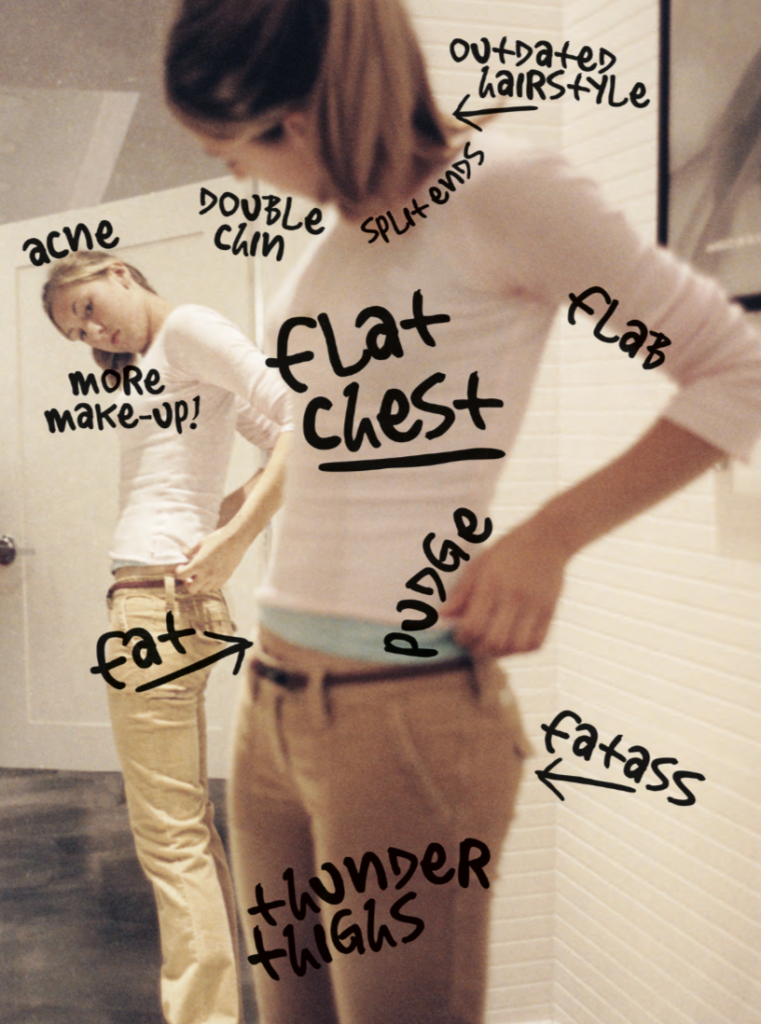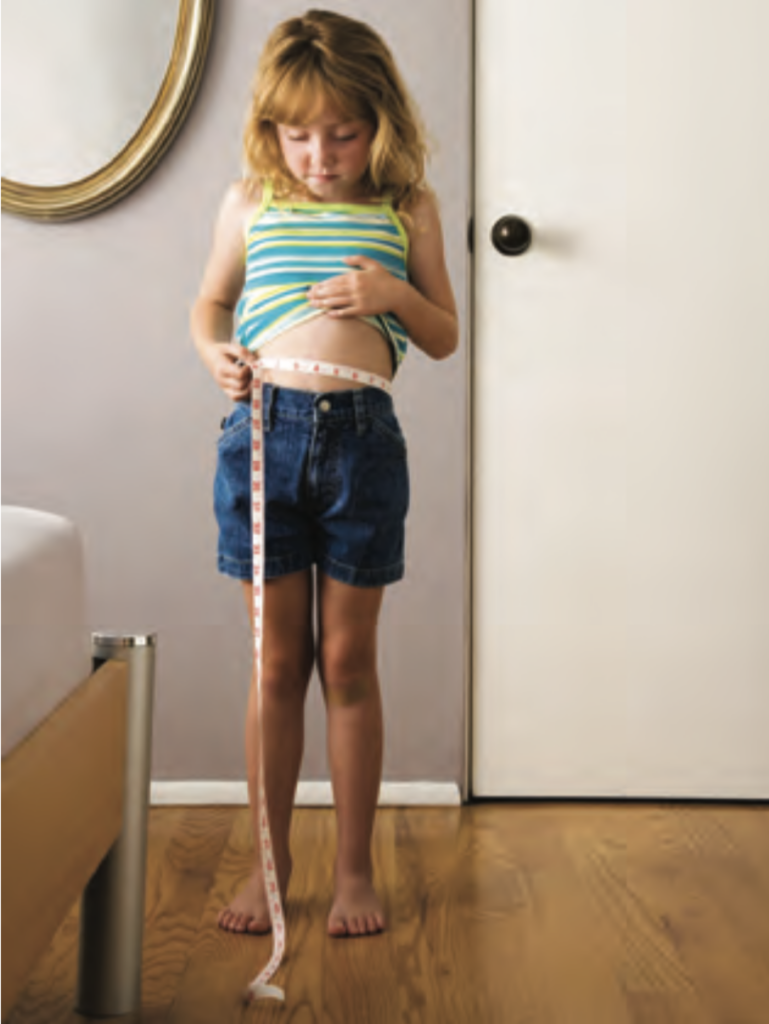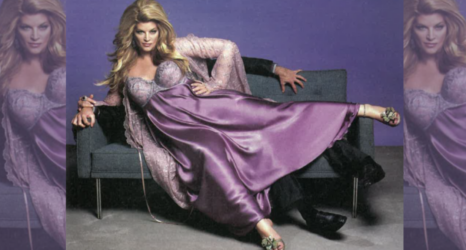
To pay tribute to five decades of reporting, rebelling and truth-telling, From the Vault includes some of our favorite feminist classics from the last 50 years of Ms. For more iconic, ground-breaking stories like this, order 50 YEARS OF Ms.: THE BEST OF THE PATHFINDING MAGAZINE THAT IGNITED A REVOLUTION (Alfred A. Knopf)—a stunning collection of the most audacious, norm-breaking coverage Ms. has published.

A steady diet of exploitative, sexually provocative depictions of women feeds a poisonous trend in women’s and girls’ perceptions of their bodies.
On a typical day, you might see ads featuring a naked woman’s body tempting viewers to buy an electronic organizer, partially exposed women’s breasts being used to sell fishing line, or a woman’s rear—wearing only a thong—being used to pitch a new running shoe. Meanwhile, on every newsstand, impossibly slim (and digitally airbrushed) cover “girls” adorn a slew of magazines. With each image, you’re hit with a simple, subliminal message: Girls’ and women’s bodies are objects for others to visually consume.
If such images seem more ubiquitous than ever, it’s because U.S. residents are now exposed to anywhere from 3,000 to 5,000 advertisements a day—up from 500 to 2,000 a day in the 1970s. The Internet accounts for much of this growth, and young people are particularly exposed to advertising: 70 percent of 15- to 34-year-olds use social networking technologies such as MySpace and Facebook, which allow advertisers to infiltrate previously private communication space.
Although mass media has always objectified women, it has become increasingly provocative. More and more, female bodies are shown as outright objects (think Rose McGowan’s machine gun leg in the recent horror movie Grindhouse), are literally broken into parts (the disembodied woman’s torso in advertisements for TV’s The Sarah Connor Chronicles) or are linked with sexualized violence (simulated crime scenes on America’s Next Top Model featuring seemingly dead women).
A steady diet of exploitative, sexually provocative depictions of women feeds a poisonous trend in women’s and girls’ perceptions of their bodies, one that has recently been recognized by social scientists as self-objectification—viewing one’s body as a sex object to be consumed by the male gaze. Like W.E.B. DuBois’s famous description of the experience of Black Americans, self-objectification is a state of “double consciousness … a sense of always looking at one’s self through the eyes of others.”
Women who self-objectify are desperate for outside validation of their appearance and present their bodies in ways that draw attention. A study I did of 71 randomly selected female students from a liberal arts college in Los Angeles, for example, found that 70 percent were medium or high self-objectifiers, meaning that they have internalized the male gaze and chronically monitor their physical appearance. Boys and men experience self-objectification as well, but at a much lower rate—probably because, unlike women, they rarely get the message that their bodies are the primary determination of their worth.
Researchers have learned a lot about self-objectification since the term was coined in 1997 by University of Michigan psychology professor Barbara Fredrickson and Colorado College psychology professor Tomi-Ann Roberts. Numerous studies since then have shown that girls and women who self-objectify are more prone to depression and low self-esteem and have less faith in their own capabilities, which can lead to diminished success in life. They are more likely to engage in “habitual body monitoring”—constantly thinking about how their bodies appear to the outside world—which puts them at higher risk for eating disorders such as anorexia and bulimia. And they are prone to embarrassment about bodily functions such as menstruation, as well as general feelings of disgust and shame about their bodies.
Self-objectification has also been repeatedly shown to sap cognitive functioning, because of all the attention devoted to body monitoring. For instance, a 1998 study asked two groups of women to take a math exam—one group in swimsuits, the other in sweaters. The swimsuit-wearers, distracted by body concerns, performed significantly worse than their peers in sweaters.

Several of my own surveys of college students indicate that this impaired concentration by self-objectifiers may hurt their academic performance. Those with low self-objectification reported an average GPA of 3.5, whereas those with high self-objectification reported a 3.1. While this gap may appear small, in graduate school admissions it represents the difference between being competitive and being out of the running for the top schools.
Another worrisome effect of self-objectification is that it diminishes political efficacy—a person’s belief that she can have an impact through the political process. In another survey of mine, 33 percent of high self-objectifiers felt low political efficacy, compared to 13 percent of low self-objectifiers. Since political efficacy leads to participation in politics, having less of it means that self-objectifiers may be less likely to vote or run for office.
The effects of self-objectification on young girls are of such growing concern that the American Psychological Association published an investigative report on it last year. The APA found that girls as young as seven years old are exposed to clothing, toys, music, magazines and television programs that encourage them to be sexy or “hot”—teaching them to think of themselves as sex objects before their own sexual maturity. Even thong underwear is being sold in sizes for 7- to 10-year-olds. The consequence, wrote Kenyon College psychology professor Sarah Murnen in the journal Sex Roles, is that girls “are taught to view their bodies as ‘projects’ that need work before they can attract others, whereas boys are likely to learn to view their bodies as tools to use to master the environment.”
Fredrickson, along with Michigan communications professor Kristen Harrison (both work within the university’s Institute for Research on Women and Gender), recently discovered that self-objectification actually impairs girls’ motor skills. Their study of 202 girls, ages 10 to 17, found that self-objectification impeded girls’ ability to throw a softball, even after differences in age and prior experience were factored out. Self-objectification forced girls to split their attention between how their bodies looked and what they wanted them to do, resulting in less forceful throws and worse aim.
One of the more stunning effects of self-objectification is its impact on sex. Nudity can cause great anxiety among self-objectifiers, who then become preoccupied with how their bodies look in sexual positions. One young woman I interviewed described sex as being an “out of body” experience during which she viewed herself through the eyes of her lover, and, sometimes, through the imaginary lens of a camera shooting a porn film. As a constant critic of her body, she couldn’t focus on her own sexual pleasure.
Self-objectification can likely explain some other things that researchers are just starting to study. For instance, leading anti-sexist male activist and author Jackson Katz observes, “Many young women now engage in sex acts with men that prioritize the man’s pleasure, with little or no expectation of reciprocity.” Could this be another result of women seeing themselves as sexual objects, not agents?
Disturbingly, some girls and women celebrate their object status as a form of empowerment. This is evident in a booming industry of T-shirts for women that proclaim their object status, such as one on which “Fuck Foreplay” is written across a half-used tube of KY Jelly, suggesting that the wearer is ready for penetration at a moment’s notice. (This shirt also propagates the notion that men do not enjoy foreplay.) Other shirts make light of rape, with words such as “Violate Me” or “No Means Eat Me Out First.”
At the root of this normalization of self-objectification may lie new consumer values in the U.S. Unlike the “producer citizen” of yesteryear—invoked in the 1960s by John F. Kennedy’s request to “ask not what your country can do for you, ask what you can do for your country”—the more common “consumer citizen” of today asks what the country, and everyone else, can do for him or her. Consumercitizens increasingly think of relationships with others as transactions in which they receive something, making them more comfortable consuming other human beings, visually or otherwise.
What would our lives look like if we viewed our bodies as tools to master our environment, instead of projects to be constantly worked on? What if our sexual expressions were based on our own pleasure as opposed to a narrow, consumerist idea of male sexual pleasure? What would disappear from our lives if we stopped seeing ourselves as objects?
Self-objectification isn’t going anywhere anytime soon. So what can we do about it?
First, we can recognize how our everyday actions feed the larger beast, and realize that we are not powerless. Mass media, the primary peddler of female bodies, can be assailed with millions of little consumer swords. We can boycott companies and engage in other forms of consumer activism, such as socially conscious investments and shareholder actions.
We can also contact companies directly to voice our concerns and refuse to patronize businesses that overtly depict women as sex objects. An example of women’s spending power, and the limits of our tolerance for objectification, can be found in the 12 percent dip in profits of clothing company Victoria’s Secret this year—due, according to the company’s CEO, to its image becoming “too sexy.” Victoria’s Secret was not the target of an organized boycott—rather, its increasingly risqué “bra and panty show” seems to have begun alienating women, who perhaps no longer want to simply be shown as highly sexualized window dressing.
Another strategy to counter one’s own tendency to self-objectify is to make a point of buying products, watching programs and reading publications that promote more authentic women’s empowerment. This can be difficult, of course, in a media climate in which companies are rarely wholeheartedly body-positive. For instance, Dove beauty products launched a much-lauded advertising campaign that used “real women” (i.e., not super-skinny ones) instead of models, but then Dove’s parent company, Unilever, put out hypersexual ads for Axe men’s body spray that showed the fragrance driving scantily clad women into orgiastic states.
Locating unadulterated television and film programming is also tough. Even Lifetime and Oxygen, TV networks created specifically for women, often portray us as weak victims or sex objects and present a narrow version of thin, white “beauty.” Action films that promise strong female protagonists (think of the women of X-Men, or Lara Croft from Tomb Raider) usually deliver these characters in skintight clothes, serving the visual pleasure of men.
Feminist media criticism, at least, is plentiful. Ms., Bitch and others, along with publications for young girls such as New Moon Magazine, provide thoughtful analyses of media from various feminist perspectives. NOW’s Love Your Body website critiques offensive ads and praises body-positive ones. Blogs, both well known and lesser known, provide a platform for women and girls to vent about how the media depicts them. And there’s some evidence that criticizing media helps defuse its effects: Murnen’s study found that grade school girls who had negative reactions to pictures of objectified women reported higher self-esteem.
A more radical, personal solution is to actively avoid media that compels us to self-objectify—which, unfortunately, is the vast majority of movies, television programs and women’s magazines. My research with college-aged women indicates that the less women consume media, the less they self-objectify, particularly if they avoid fashion magazines. By shutting out media, girls and women can create mental and emotional space for true self-exploration.
What would our lives look like if we viewed our bodies as tools to master our environment, instead of projects to be constantly worked on? What if our sexual expressions were based on our own pleasure as opposed to a narrow, consumerist idea of male sexual pleasure? What would disappear from our lives if we stopped seeing ourselves as objects? Painful high heels? Body hatred? Constant dieting? Liposuction? Unreciprocated oral sex?
It’s hard to know. Perhaps the most striking outcome of self-objectification is the difficulty women have in imagining identities and sexualities truly our own. In solidarity, we can start on this path, however confusing and difficult it may be.
Up next:





